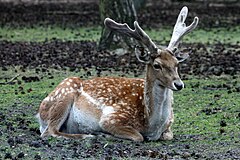Daniel (rodzaj ssaka)
| Dama[1] | |||
| Frisch, 1775[2] | |||
 Przedstawiciel rodzaju – daniel mezopotamski (D. mesopotamica) | |||
| Systematyka | |||
| Domena | |||
|---|---|---|---|
| Królestwo | |||
| Typ | |||
| Podtyp | |||
| Gromada | |||
| Podgromada | |||
| Infragromada | |||
| Rząd | |||
| Podrząd | |||
| Infrarząd | |||
| Rodzina | |||
| Podrodzina | |||
| Plemię | |||
| Rodzaj | daniel | ||
| Typ nomenklatoryczny | |||
Cervus dama Linnaeus, 1758 | |||
| Synonimy | |||
| Gatunki | |||
| |||
Daniel[11] (Dama) – rodzaj ssaka z podrodziny jeleni (Cervinae) w obrębie rodziny jeleniowatych (Cervidae).
Zasięg występowania
Rodzaj obejmuje gatunki występujące pierwotnie w Turcji[12][13][14]. Introdukowany w wielu regionach świata[14][15].
Morfologia
Długość ciała samic 130–170 cm, samców 145–190 cm, długość ogona 16–20 cm, wysokość w kłębie samic 70–90 cm, samców 85–110 cm; długość poroża samców 50–86 cm; masa ciała samic 35–80 kg, samców 50–140 kg[13].
Systematyka
Etymologia
- Dama: epitet gatunkowy Cervus dama Linnaeus, 1758; łac. dama, damma „daniel, antylopa, kozica”[16].
- Platyceros: gr. πλατυς platus „szeroki”; κερας keras, κερατος keratos „róg”[17]. Gatunek typowy: Platyceros plinii E.A.W. Zimmermann, 1780 (= Cervus dama Linnaeus, 1758).
- Dactyloceros: gr. δακτυλος daktulos „palec”; κερας keras, κερατος keratos „róg”[18].
- Palmatus: łac. palmatus „dłoniasty”, od palma „dłoń”[19].
- Notomegaceros: gr. νοτος notos „południe”; rodzaj Megaceros R. Owen, 1844[10]. Gatunek typowy: †Cervus carburangelensis De Gregorio, 1925.
Podział systematyczny
Do rodzaju należą następujące występujące współcześnie gatunki[12][11]:
- Dama dama (Linnaeus, 1758) – daniel zwyczajny
- Dama mesopotamica (Brooke, 1875) – daniel mezopotamski
Opisano również gatunki wymarłe:
- Dama carburangelensis (De Gregorio, 1925)[20] (Europa; plejstocen).
- Dama eurygonos Azzaroli, 1947[21] (Europa; plejstocen).
- Dama geiselana Pfeiffer, 1998[22] (Europa; plejstocen).
- Dama roberti Breda & Lister, 2013[23] (Europa; plejstocen).
- Dama vallonnetensis (De Lumley, Kahlke, Moigne & Moullé, 1988)[24] (Europa; pliocen–plejstocen)
Uwagi
Przypisy
- ↑ Dama, [w:] Integrated Taxonomic Information System [online] (ang.).
- ↑ J.L. Frisch: Das Natur-System der Vierfüßigen Thiere. Glogau: Christian Friedrich Günther, 1775, s. 3. (niem.).
- ↑ E.A.W. von Zimmermann: Geographische Geschichte des Menschen, und der allgemein verbreiteten vierfüßigen Thiere. Cz. 2. Leipzig: Weygand, 1780, s. 128. (niem.).
- ↑ a b Anonim. Opinion 581. Determination of the generic names for the fallow deer of Europe and the Virginia deer of America (Class Mammalia). „The Bulletin of zoological nomenclature”. 17 (9–11), s. 267–275, 1960. (ang.).
- ↑ J.E. Gray. An Outline of an Attempt at the Disposition of Mammalia into Tribes and Families, with a List of the Genera apparently appertaining to each Tribe. „Annals of Philosophy”. New Series. 10, s. 342, 1825. (ang.).
- ↑ C.H. Smith: Synopsis of the species of the class Mammalia. W: G. Cuvier & E. Griffith (red.): The animal kingdom: arranged in conformity with its organization. Cz. 5. London: G.B. Whittaker, 1827, s. 306. (ang.).
- ↑ J.A. Wagner: Supplementband. W: J.Ch.D. von Schreber: Die Säugthiere in Abbildungen nach der Natur, mit Beschreibungen. Cz. 4: Die Nager (zweiter Abschnitt), Bahnlücker, Einhufer, Dickhäuter und Wiederkäuer. Erlangen: Expedition des Schreber’schen säugthier- und des Esper’schen Schmetterlingswerkes, 1844, s. 340. (niem.).
- ↑ J.A. Wagner: Supplementband. W: J.Ch.D. von Schreber: Die Säugthiere in Abbildungen nach der Natur, mit Beschreibungen. Cz. 5: Die Affen, Bahnlücker, Beutelthiere, Susthiere, Tusettenfresser und Sandflüger. Erlangen: Expedition des Schreber’schen säugthier- und des Esper’schen Schmetterlingswerkes, 1855, s. 349, 352. (niem.).
- ↑ R. Lydekker: The deer of all lands; a history of the family Cervidæ living and extinct. London: R. Ward, limited, 1898, s. 125. (ang.).
- ↑ a b E. Gliozzi & A. Malatesta. A Megacerine in the Pleistocene of Sicily. „Geologica Romana”. 21, s. 311, 1982. (ang.).
- ↑ a b Nazwy zwyczajowe za: W. Cichocki, A. Ważna, J. Cichocki, E. Rajska-Jurgiel, A. Jasiński & W. Bogdanowicz: Polskie nazewnictwo ssaków świata. Warszawa: Muzeum i Instytut Zoologii PAN, 2015, s. 175. ISBN 978-83-88147-15-9. (pol. • ang.).
- ↑ a b C.J. Burgin, D.E. Wilson, R.A. Mittermeier, A.B. Rylands, T.E. Lacher & W. Sechrest: Illustrated Checklist of the Mammals of the World. Cz. 2: Eulipotyphla to Carnivora. Barcelona: Lynx Edicions, 2020, s. 310. ISBN 978-84-16728-35-0. (ang.).
- ↑ a b S. Mattioli: Family Cervidae (Deer). W: D.E. Wilson & R.A. Mittermeier (red. red.): Handbook of the Mammals of the World. Cz. 2: Hoofed Mammals. Barcelona: Lynx Edicions, 2011, s. 416–417. ISBN 978-84-96553-77-4. (ang.).
- ↑ a b D.E. Wilson & D.M. Reeder (red. red.): Genus Dama. [w:] Mammal Species of the World. A Taxonomic and Geographic Reference (Wyd. 3) [on-line]. Johns Hopkins University Press, 2005. [dostęp 2021-04-05]. (ang.).
- ↑ Na sztywnych nogach. „National Geographic Polska”, 2000-08. Gruner+Jahr Polska. ISSN 1507-5966. (pol.).
- ↑ Palmer 1904 ↓, s. 215.
- ↑ Palmer 1904 ↓, s. 543.
- ↑ Palmer 1904 ↓, s. 214.
- ↑ Palmer 1904 ↓, s. 507.
- ↑ A. de Gregorio. Mammiferi quaternari di Sicilia. Parte III. Sul genere Cervus. „Annales de Géologie et de Paléontologie”. 40, s. 1–17, 1925. (wł.).
- ↑ A. Azzaroli. I cervi fossili della Toscana. „Palaeontographia Italica”. 43, s. 46-81, 1947. (wł.).
- ↑ T. Pfeiffer. Die fossilen Damhirsche von Neumark-Nord (Sachsen-Anhalt) – D. dama geiselana n. ssp. „Eiszeitalter und Gegenwart”. 48, s. 75, 1998. (niem.).
- ↑ M. Breda & A.M. Lister. Dama roberti, a new species of deer from the early Middle Pleistocene of Europe, and the origins of modern fallow deer. „Quaternary Science Reviews”. 69, s. 157, 2013. DOI: 10.1016/j.quascirev.2013.01.029. (ang.).
- ↑ H. de Lumley, H.D. Kahlke, A.M. Moigne & P.E. Moulle. Les faunes de grands mammiferes de la grotte du Vallonet (Roguebrune-Cap-Martin, Alpes-Maritimes). „L’Anthropologie”. 92 (2), s. 465–495, 1988. (fr.).
Bibliografia
- T.S. Palmer. Index Generum Mammalium: a List of the Genera and Families of Mammals. „North American Fauna”. 23, s. 1–984, 1904. (ang.).
Media użyte na tej stronie
Autor: (of code) -xfi-, Licencja: CC BY-SA 3.0
The Wikispecies logo created by Zephram Stark based on a concept design by Jeremykemp.
Autor: ©noisytoy.net, Licencja: CC BY-SA 4.0
Mesopotamisch damhert, mannetje

